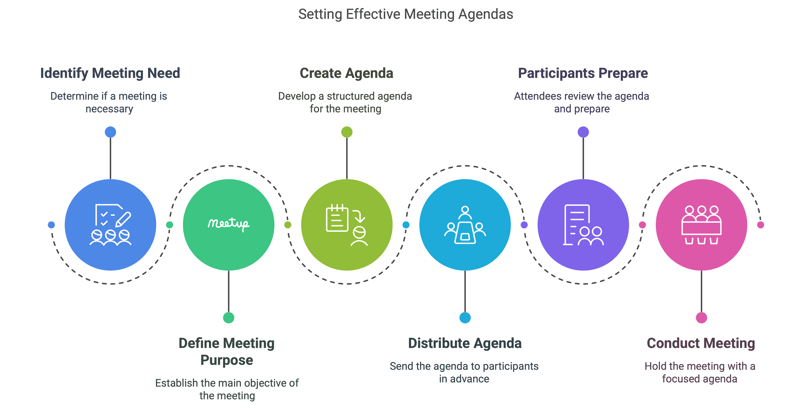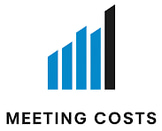The Hidden Cost of Unproductive Meetings – And How to Fix It
Discover the shocking financial impact of inefficient meetings on your business. The average employee spends 31 hours monthly in unproductive meetings, costing U.S. businesses $399 billion annually. Learn our 5-step framework to eliminate meeting waste, leverage HubSpot's tools for better collaboration, and potentially cut meeting time by 50%. Includes a free Meeting Cost Calculator to quantify your savings opportunity. Stop watching your budget drain away in unnecessary meetings—read now to transform your team's productivity.
C. Carnoli
3/3/20256 min read


In today's fast-paced business environment, time is perhaps our most valuable resource. Yet many organizations unknowingly hemorrhage this precious asset through a seemingly innocuous business practice: meetings. While collaboration is essential for innovation and progress, the reality is that unproductive meetings have become a silent productivity killer with substantial financial implications.
This comprehensive guide will examine the true cost of inefficient meetings, provide actionable strategies to optimize your meeting culture, and introduce tools that can transform how your team collaborates.
The Staggering Financial Impact of Unproductive Meetings
The numbers behind meeting inefficiency tell a sobering story that should concern every business leader:
The average employee spends 31 hours per month in unproductive meetings—equating to almost four full workdays.
Middle managers dedicate approximately 35% of their work week to meetings, while executives spend up to 23 hours weekly—with surveys indicating that 71% of these meetings are considered unproductive.
U.S. businesses collectively waste an estimated $399 billion annually due to inefficient meetings—a figure that should prompt immediate reflection on your organization's meeting practices.
Understanding Your Meeting ROI
To conceptualize the real cost of meetings, consider this practical example:
A one-hour meeting with 10 employees who each earn an average salary of $80,000 per year costs approximately $500 in direct labor costs alone. This calculation doesn't account for opportunity costs—what these talented professionals could have accomplished during that time instead.
For a mid-sized company with 100 employees who each attend just 10 hours of unnecessary meetings per month, the annual cost exceeds $500,000. This represents a significant drain on resources that could be redirected toward innovation, customer service, or other revenue-generating activities.
The 5 Most Common Meeting Productivity Killers
Before implementing solutions, it's crucial to identify the primary causes of meeting inefficiency:
1. Absence of Clear Agendas and Objectives
The Problem:
Research from Harvard Business Review found that 63% of meetings occur without a planned agenda. Without clear direction, meetings naturally drift into unfocused discussions, side conversations, and ultimately, wasted time.
The Solution:
Every meeting should have a structured agenda with specific objectives distributed in advance. Tools like Fellow provide excellent agenda templates and collaborative note-taking features that ensure meetings stay on track. HubSpot's meeting tools also integrate agenda creation directly into their calendar functionality, allowing participants to come prepared with relevant information.
2. Excessive Participation
The Problem:
Amazon's Jeff Bezos popularized the "Two-Pizza Rule"—if a meeting requires more food than two pizzas can provide, there are too many attendees. Large meetings dilute accountability, slow decision-making, and significantly increase their organizational cost.
The Solution:
Limit meeting attendance to essential stakeholders only. For decision-making meetings, research suggests 6-8 participants maximize effectiveness. Task management platforms like ClickUp and HubSpot's project management tools allow for asynchronous progress updates, eliminating the need for status-update meetings with unnecessary participants.
3. The "This Could Have Been an Email" Syndrome
The Problem:
A study by Atlassian found that 45% of employees feel overwhelmed by the number of meetings they attend, with many of these gatherings conveying information that could be shared through other channels.
The Solution:
Before scheduling a meeting, ask: "Is real-time discussion necessary?" For information sharing, updates, or simple decisions, consider asynchronous alternatives. Tools like Loom allow for detailed video explanations that recipients can watch on their own time, while HubSpot's communication features facilitate organized information sharing without requiring synchronous attendance.
4. Poor Time Management
The Problem:
Parkinson's Law states that work expands to fill the time allotted. The standard 30 or 60-minute meeting block often results in discussions that consume the entire allocated time, regardless of necessity.
The Solution:
Challenge the default meeting duration. Consider 15 or 25-minute meetings instead of 30, and 45-minute meetings instead of 60. Scheduling tools like Motion and HubSpot Calendar allow for customized meeting durations and can automatically block off "deep work" time to protect your team's productivity.
5. Lack of Action Items and Accountability
The Problem:
Without clear next steps, meetings often become circular discussions that necessitate follow-up meetings. Approximately 67% of meetings end without documented action items, according to meeting analytics company Docket.
The Solution:
End every meeting by summarizing decisions and assigning specific actions with deadlines. AI-powered transcription services like Otter.ai can automatically extract action items from meeting discussions. HubSpot's CRM also allows teams to create and assign tasks directly from meeting notes, ensuring accountability and progress tracking.
Strategic Approaches to Reduce Meeting Burden
Now that we've identified the key problems, let's explore comprehensive strategies to transform your meeting culture:
1. Implement a Company-Wide Meeting Audit
Begin by cataloging all recurring meetings across your organization. For each, answer these questions:
What is the specific purpose and desired outcome?
Who absolutely needs to attend?
Could this be accomplished asynchronously?
What would happen if this meeting didn't occur?
This audit typically identifies 30-40% of meetings that can be eliminated or significantly shortened without negative consequences.
2. Establish a "Meeting Budget"
Just as financial budgets control spending, a meeting budget limits the hours teams can spend in collaborative sessions. Some organizations have implemented "meeting-free days" or designated focus time blocks where no internal meetings can be scheduled.
Tools like Clockwise and HubSpot's calendar management features can help enforce these policies by automatically blocking protected time and suggesting optimal meeting slots that minimize disruption to deep work.
3. Adopt the "10-30-50-90" Meeting Framework
This framework categorizes meetings by duration, each with specific protocols:
10-minute check-ins: Standing meetings for quick updates
30-minute discussions: For focused problem-solving with strict agendas
50-minute workshops: For collaborative work with clear deliverables
90-minute deep dives: Reserved for complex strategic issues
By categorizing meetings this way, teams become more intentional about the time they request from colleagues.
4. Leverage Technology for Meeting Optimization
Modern collaboration tools can dramatically reduce meeting overhead:
AI-powered meeting assistants: Platforms like Otter.ai provide real-time transcription and summary generation, allowing team members to review meetings they couldn't attend.
Asynchronous video communication: Tools like Loom enable detailed explanations without requiring real-time attendance. These videos can be watched at 1.5x speed, further increasing efficiency.
Collaborative workspaces: Platforms like Twist prioritize asynchronous communication over real-time interruptions, creating a more focused work environment. HubSpot's internal communication tools similarly facilitate organized information sharing without requiring meetings.
Meeting analytics: Services like Fellow and Hypercontext measure meeting effectiveness and provide data-driven insights for continuous improvement.
5. Create a Meeting-Minimal Culture
Beyond tools and policies, cultural change is essential:
Normalize saying no: Empower employees to decline meetings where their presence isn't critical.
Start with written communication: Encourage teams to begin with documents that articulate ideas clearly before scheduling discussion time.
Reward meeting efficiency: Recognize teams that accomplish more while meeting less.
Tool Recommendations for Different Meeting Challenges
Different meeting problems require different solutions. Here's a targeted guide to the most effective tools for specific meeting challenges:
For Agenda Management and Meeting Structure
Fellow: Offers collaborative agendas, notes, and action item tracking
HubSpot Meetings: Provides scheduling, agenda creation, and CRM integration
Hypercontext: Specializes in one-on-one and team meeting agendas with goal tracking
For Reducing Meeting Frequency
ClickUp: Comprehensive project management that reduces the need for status updates
Twist: Asynchronous communication platform designed to replace unnecessary meetings
HubSpot's Task Management: Allows for clear assignment and tracking of responsibilities
For Enhancing Meeting Efficiency
Otter.ai: AI-powered meeting transcription and note-taking
Loom: Video messaging platform for asynchronous updates
Zoom AI Companion: Provides automated meeting summaries and action items
For Better Time Management
Motion: AI calendar that optimizes scheduling and protects focus time
Clockwise: Automatically finds the best meeting times to preserve deep work
HubSpot Calendar: Integrates with your CRM for contextual meeting scheduling
Measuring the ROI of Meeting Optimization
How do you know if your meeting reform efforts are successful? Track these metrics:
Total meeting hours per employee: Aim for a 30-50% reduction
Meeting satisfaction scores: Survey participants on meeting effectiveness
Decision velocity: Measure how quickly decisions are made
Deep work hours: Track time available for focused, uninterrupted work
Many organizations that have implemented these strategies report not only cost savings but also increased employee satisfaction, reduced burnout, and improved work-life balance.
The Meeting Cost Calculator: Quantify Your Opportunity
To understand the potential impact of meeting optimization for your specific organization, use a Meeting Cost Calculator. This simple tool multiplies:
Number of attendees
Average hourly salary (annual salary ÷ 2,080 working hours per year)
Meeting duration
Frequency of the meeting
For a team of 50 employees earning an average of $75,000 annually, reducing weekly meeting time by just 2 hours per person could save approximately $3,750 per week—or $195,000 annually.
Conclusion: Beyond Meeting Reduction
The goal isn't to eliminate all meetings—meaningful collaboration remains essential for innovation and team cohesion. Rather, the objective is to make every meeting purposeful, efficient, and worth the investment of your team's valuable time.
By implementing the strategies outlined in this article and leveraging the right combination of tools like HubSpot, ClickUp, Otter.ai, Loom, and others, you can transform your organization's approach to meetings from a productivity drain to a competitive advantage.
Remember that meeting optimization is an ongoing process, not a one-time initiative. Regularly reassess your meeting culture, gather feedback, and continue refining your approach to collaborative work.
What meeting inefficiencies is your organization struggling with? Share your challenges and successes in the comments below.
Want to learn more about optimizing your team's productivity? Subscribe to our newsletter for weekly insights on working smarter, not harder.


Connect
Get in touch for meeting cost solutions.
Resources
© 2025. All rights reserved.
